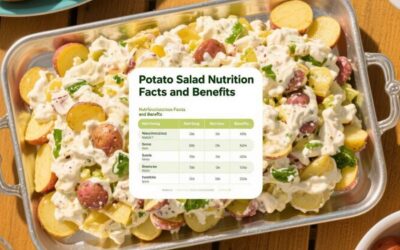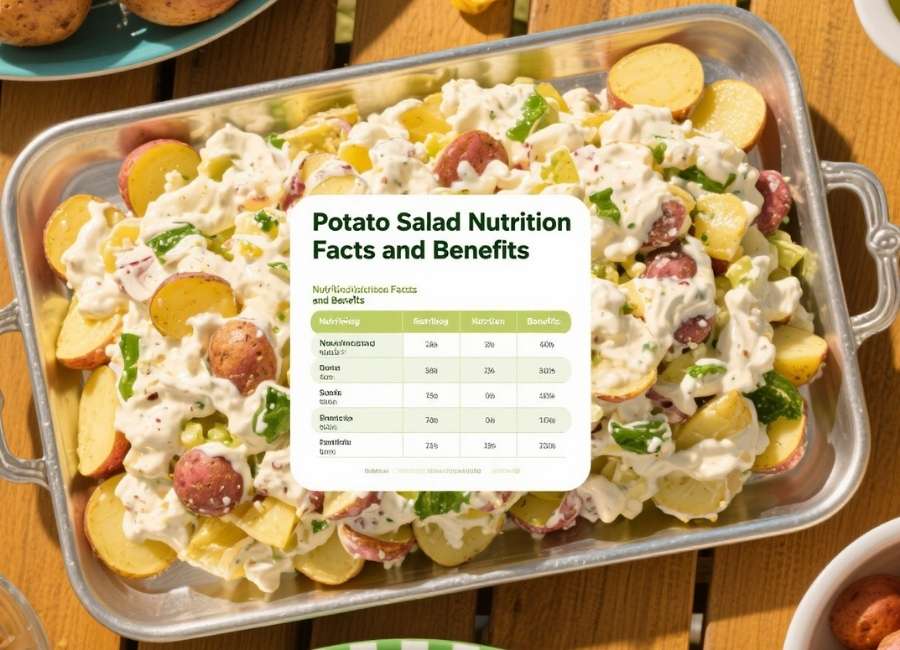Potato salad is a classic dish loved by many. Whether it’s served at a summer barbecue, a family gathering, or part of a hearty lunch, its creamy texture and flavorful taste make it irresistible. But when it comes to health, how does potato salad stack up? Is it a valuable source of nutrients, or is it simply a calorie-laden side dish?
This blog takes a detailed look at the nutritional aspects of potato salad. By the end, you’ll understand its health benefits, how to make it nutritious, and what to consider if you’re watching your diet.
The Nutrition Basics of Potato Salad

At its core, potato salad is a mix of boiled potatoes, a creamy dressing (often mayonnaise or sour cream), and various add-ins like herbs, vegetables, or eggs. Here’s a breakdown of its typical nutrition:
Potatoes
Potatoes are the star ingredient of potato salad, bringing a wealth of nutrients to the table:
- Calories: A serving of boiled potatoes contains about 77 calories per 100 grams.
- Carbohydrates: Potatoes are high in carbohydrates, delivering energy in the form of starch.
- Vitamin C: Did you know potatoes are an excellent source of vitamin C? This antioxidant supports your immune system and promotes healthy skin.
- Potassium: Essential for muscle function and maintaining healthy blood pressure, potassium is abundant in potatoes.
- Fiber: When prepared with the skin, potatoes provide dietary fiber, which aids digestion.
Mayonnaise and Dressing
The dressing in potato salad is what often defines its taste and texture, but it also significantly impacts its nutrition:
- Calories and Fats: Mayonnaise is high in calories and saturated fats. One tablespoon contains about 94 calories and 10 grams of fat.
- Protein: Despite being calorie-dense, mayonnaise is a source of protein due to its egg content.
Common Add-ins
The ingredients you add to your potato salad play a big role in its overall nutrition:
- Eggs: Provide protein, vitamin D, and choline.
- Celery or Onions: Add a crunch and a dose of vitamins and antioxidants.
- Herbs (like parsley or dill): Offer micronutrients and enhance flavor without added calories.
Overall Caloric Content
A standard serving of potato salad (roughly 1 cup) typically has:
- Calories: Around 250-350, depending on the dressing and add-ins.
- Protein: 2-3 grams.
- Fat: 15-25 grams.
- Carbohydrates: 20-30 grams.
The Health Benefits of Potato Salad

Despite its reputation as a high-calorie dish, potato salad does have noteworthy health benefits when eaten in moderation.
1. Provides Energy
The carbohydrates in potatoes are an excellent energy source, making potato salad a great side dish to fuel your day.
2. Packed with Vitamins and Minerals
Potatoes are loaded with potassium and vitamin C, both of which are essential for muscle and immune health. Add in eggs and vegetables, and you enrich the dish with even more nutrients.
3. Supports Digestive Health
If you leave the skins on or opt for whole-grain mustard or other fiber-rich add-ins, potato salad can contribute to your daily fiber intake.
4. Resistant Starch
When potatoes are cooled after cooking, something amazing happens. Their starch content transforms into resistant starch, a type of fiber that can improve gut health and help regulate blood sugar levels.
Making Potato Salad More Nutritious

If you love potato salad but want to keep it healthy, here are a few simple swaps and tips:
1. Change Up the Dressing
- Use Greek Yogurt: Swap out mayonnaise for Greek yogurt to reduce calories and fat while increasing protein.
- Opt for Olive Oil-Based Dressings: A simple vinaigrette with olive oil and lemon juice adds healthy fats and vibrant flavor.
2. Choose the Right Potatoes
- Stick with Red or Fingerling Potatoes: These varieties are lower in starch and maintain their structure better, making them ideal for potato salad.
- Keep the Skin On: Potato skins pack a lot of nutrients and add a rustic touch to your dish.
3. Add More Vegetables
- Bulk It Up with Veggies: Include celery, radishes, bell peppers, or even roasted zucchini to brighten your potato salad and increase vitamins and fiber.
- Fresh Herbs: Herbs like dill, parsley, or chives not only elevate flavor but add essential micronutrients.
4. Include Lean Protein
Adding lean proteins such as boiled eggs, grilled chicken strips, or even chickpeas can enhance the nutritional profile of your potato salad.
What to Watch Out For
While potato salad has benefits, there are a few things to keep an eye on, especially if you’re mindful of your health:
- Portion Size: Due to its calorie density, eating large portions of potato salad can add up quickly.
- Sodium Content: Store-bought mayonnaise and dressings are often high in sodium. Opt for low-sodium options or make your own dressing to control the salt.
- Sugar in Store-Bought Options: Some store-bought potato salads contain added sugars to enhance flavor. Always check the label.
The Final Forkful
Potato salad isn’t just reserved for picnics and backyard barbecues. It’s a versatile dish that, when prepared thoughtfully, can be a nutritious addition to your diet.
Whether you tweak the dressing for a healthier option, pack it with colorful veggies, or keep your serving sizes in check, potato salad can remain a delicious classic that aligns with your health goals.
Next time you enjoy a scoop of creamy potato salad, you’ll know exactly what you’re getting. And if you’re ready to try a new recipe, experiment with some of the tips we’ve shared. Your taste buds (and body) will thank you!



















